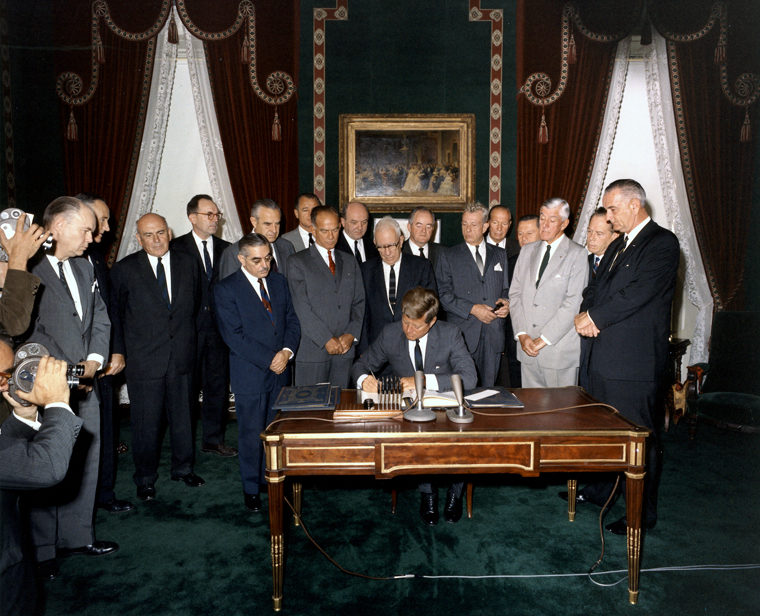
The Cold War saw a series of serious efforts towards nuclear arms control. Cold War rivals—the Soviet Union and the United States—conceived the principles of deterrence, strategic stability, limited nuclear war, and more. However, like all “third-tier” nuclear states, India and Pakistan have inherited these concepts. This automatically leads some to conclude that the South Asian rivals would tread the same path and draw the same lessons about arms control and risk reduction as the Cold War rivals did. However, important differences in dynamics between India and Pakistan have limited the applicability of many of the lessons from the Cold War experience.
At the heart of these differences lies a structural factor: geography. Pakistan and India are contiguous, with a volatile border, and are drastically discrepant in terms of both size and power. India, the larger military and economic power, is not prepared to deal with Pakistan on an equal footing and thus does not want to talk arms control with its smaller neighbor. On the other hand, Pakistan is mired by several challenges internally as well as externally. This imbalance in conventional power dynamics hinders meaningful thinking about the subject of risk reduction and arms control mechanisms. The Cold War rivals, on the other hand, were near equal in power. Because neither side could assert superiority over the other in nuclear negotiations, they were more amenable to sort out nuclear concerns together.
The large distance between the United States and the Soviet Union further made negotiations easier with both sides not having to deal with the extreme complications of a shared border and disputed territory, like India and Pakistan. Territorial contiguity has ramifications for strategy; Indian and Pakistani ballistic missiles can reach key target locations within each other’s territories in as little as a few minutes. What complicates this further is India’s limited war doctrine, which propounds the use of small corps to launch multiple shallow strikes into Pakistani territory to hold it for leverage in a post-war bargaining scenario, and Pakistan’s first-use nuclear doctrine. In such a situation, rational decisionmaking becomes all the more difficult since there isn’t sufficient time to conceive a response that would reap optimal results. Therefore, a perceived impending attack, by either side, might lead to hasty decisions, thus increasing the risk of inadvertent escalation.
The push toward arms control and safer deterrence measures between the United States and the Soviet Union came from incidents such as the 1962 Cuban Missile Crisis. However, what that crisis did for the United States and the Soviet Union, the Kargil War did not do for India and Pakistan. This could be because Kargil happened too soon after the two states went overtly nuclear—Pakistan and India had spent considerable time and resources in developing a nuclear weapons capability and were not going to halt their programs at the first sign of a crisis. In contrast, in the wake of the Cuban Missile Crisis, thinking in the United States shifted towards the need for introducing measures to prevent future catastrophes. The Partial Test Ban Treaty, signed by the Cold War superpowers the following year, served as an ice-breaker between the two countries and paved the way for further agreements.
Moreover, psychological and historic factors, such as a bloody history that led to the partition of India and Pakistan, three wars over Kashmir, and an enduring rivalry all impede thinking about arms control in South Asia. The United States and the Soviet Union did not share such a personal, emotive history. Their respective strategic cultures and their rivalry came to the fore during the post-WWII bipolar global structure. In contrast, the South Asian rivals acquired nuclear weapons long after their rivalry was initially established. Nuclear weapons simply added a new dimension to their strategic thinking. The lack-of-history factor and the absence of outstanding territorial disputes between the Cold War superpowers played a significant role in their agreement over certain measures to mitigate their dangerous arms race, particularly in comparison to India and Pakistan. When it comes to the two South Asian rivals, neither side has been able to cross the psychological barrier to take meaningful steps in that direction.
Furthermore, as opposed to the bipolar rivalry of the Cold War, the South Asian conundrum has a third pole. China, the Asian giant that borders both South Asian adversaries, also factors into this relationship. China and Pakistan have shared a history of friendly relations, while India eyes China warily, given the latter’s great power status and their checkered history that includes a border war. Accordingly, India’s nuclear program is directed at two rivals instead of one, both of whom are nuclear weapons states. Thus, the success of a mechanism for arms control between Pakistan and India depends not only on the Islamabad-New Delhi relationship but also on the Beijing-New Delhi-Beijing, which further impedes the prospects of India and Pakistan coming to the table.
This is not to say that the Cold War case was less complicated, but the South Asian nuclear relationship differs in significant ways that render it difficult for India and Pakistan to follow in the footsteps of the Cold War rivals. Hence, with India and Pakistan’s aggressive nuclear and conventional arms buildup and belligerent political rhetoric, there is urgent need for actors in South Asia to employ novel ways of thinking about how to minimize any nuclear or potentially-nuclear crises in the region.
***


